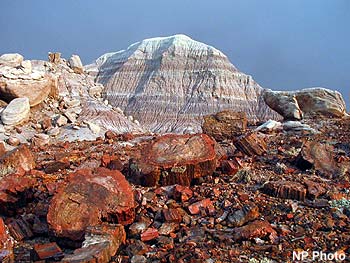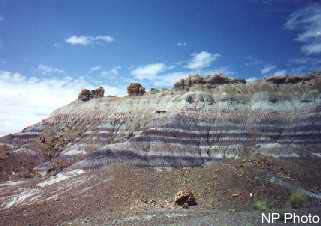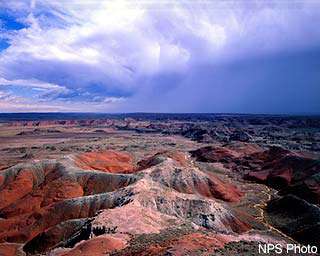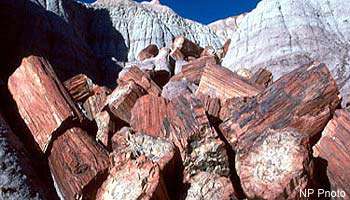Petrified Forest National Park, AZ
The Petrified Forest National Park in northern Arizona was created to preserve the mineralized remains of Mesozoic Forests commonly known as the "Petrified Forest." The park is not only rich in plant fossils, but is an important site for Triassic vertebrate fossils. The park contains important archeological resources, including some of the most important rock art sites in the southwest, and several rare, endangered, and threatened species. Also included in the park's 93,533 acres are the multi-hued badlands of the Chinle Formation known as the Painted Desert, historic structures, archeological sites and displays of 225 million-year-old fossils.
Petrified Forest National Park (PEFO) contains an extensive variety of significant natural and cultural resources, including some of the most valuable paleontological worldwide resources. The Chinle formation at Petrified Forest, recognized for the spectacular scenic landscapes of the Painted Desert and Blue Mesa, is one of the best places in the world for studying the Triassic period of the Earth's history. The Triassic period is considered by some palezoologists and paleobotanists to be the time when all modern ecosystems were established. PEFO contains unusually diverse Triassic fossil beds because of the unique series of geological events that occurred over extended time intervals. During the Triassic, enormous amounts of volcanic deposition (silt, mud, volcanic ash) were conducive to the rapid burial, preservation, and fossilization of the plants and animals inhabiting the ancient forest and adjacent lowlands. The petrified Araucarioxylon, Woodworthia, and Schilderia logs, commonly seen throughout the park today, are the remains of tall coniferous trees that fell and were subsequently carried by streams into the ancient flood plain.
By 100 million years ago, the area that would eventually become the park was buried under thick layers of sediment. Approximately 35 million years ago, the strata were uplifted, increasing their exposure to wind and rain which, over time, would remove numerous layers of "protective" sediments. Today, as the erosion process continues, additional logs are exposed as well as other important vertebrate fossils which may eventually degrade or lose their provenance. In some Triassic beds, up to 90 meters (300 feet) of fossil-bearing material remains. Exposed deposits within the park have contained over 148 species of fossilized plants and over 50 species of fossilized animals. Notable representatives of fossilized animals include metoposaurs (amphibians) and several thecodonts such as phytosaurs, aetosaurs, and poposaurs (early reptiles). Collectively, the ancient associations of plants and animals are representative of earlier Triassic ecosystems.
Summer hours are 7:00am to 7:00pm MST.
Winter hours are 8:00am to 5:00pm MST.




